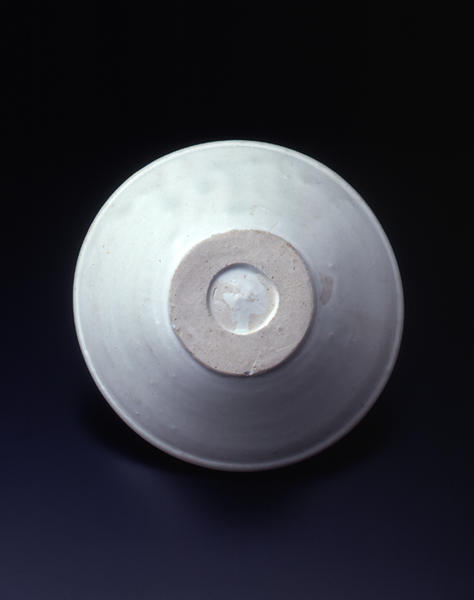白磁碗
- 邢州窯
- 中国・唐時代
- 9c
- 白磁製
- H-4.5 W-15
解説(春の玉手箱)
ここでいう白磁とは白い胎土に、無色透明もしくは白色半透明釉をかけて焼成したせっ器・半磁器をいう。中国で白磁が焼き始められたのは魏晋南北朝時代の北朝においてで、唐時代に需要の高まりとともに全国的にひろがった。晩唐の白磁の基準とされているものに広東省広州市北郊建設村の姚潭墓(大中一二年、八五八)から出土した二碗がある。そのうちの一碗とほぼ同じ作行きの典型的な晩唐時代の白磁碗である本作は、口縁を折り返して玉縁とし、ほぼ直線的に開く胴部の稜線をもつ。胎土は白く、やや青みを帯びた白釉がかけられ、よく焼き締まっている。底部は蛇目高台となし、高台畳付は露胎であるが高台内には釉がかけられている。全体に整った美しい形姿をなしている。元来は日常の食器である碗という器種であるが、頃合の大きさと清廉な白色であることから涼を呼ぶ夏茶碗として転用されている。
Catalogue Entry
The term white ware is used here to refer to a white‐bodied stone ware or semi‐porcelainous ware which is fired with either a transparent glaze or a semi‐transparent, white glaze. White wares were first fired in China during the Northern Dynasty of the period of Northern and Southern Dynasties, and an increased demand during the Tang dynasty led to their spread throughout China. Two bowls excavated from the tomb dated 858, set the standard for white wares of the Late Tang dynasty. The present bowl is a typical Late Tang white ware bowl with essentially the same formation style as that seen on one of the excavated tomb bowls. The rim of the Miho bowl is turned back into an everted rim and it has a diagonal silhouette formed from the almost straight line expansion of the torso. The body clay is white and is coated in a slightly bluish tinged white glaze. Overall the work has been well fired. The base has an open‐center foot, and while the bottom edges of the foot are unglazed, the center of the foot has been glazed. The bowl has a symmetrical, well arranged beauty.

